Wednesday, May 30, 2007
Home Again
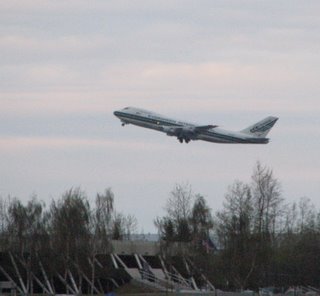
To my fellow TAS – Sorry, we were not near sea-ice this trip. We do have CTD data from the Gulf. I’m back in New York, but would be happy to connect you with the scientists in Seattle if you would like to get more information or possibly a sample.
Monday, May 28, 2007
Kodiak, Alaska
NOAA Ship MILLER FREEMAN
Mission: Fisheries Oceanography Coordinated Investigations
Day 10: May 28, 2007
Last night we stopped survey operations and sailed for the Coast Guard Station in Kodiak, Alaska. We went through a part of the island called Whale Pass. We saw whales blowing in the distance, sea otters drifting with the tide and a spectacular Alaska sunset that seemed to go on forever.
Today I had a day on Kodiak Island while I wait for my flight out tomorrow. What an amazing day. I tried to rent a car in the airport and was unsuccessful. I was sad at first, and then set out to make the best of it by exploring on foot. I started with some lunch. What a treat! For Memorial Day, Kodiak had something called a Crab Festival. There were rides, treats, and of course, Alaska King Crab. Take a look a lunch today!
I next set off on a long hike through the areas near the town of Kodiak. Lieutenant Sean had given me a list and guide to the town, and using that, I visited the harbors near town, and then a park just outside of town where I was able to hike through spruce trees covered with moss, and then find isolated beaches full of birds, including eagles.
Next, I decided to hike to the top of a mountain overlooking Kodiak, again, following Lieutenant Sean's recommendation. I found myself on top of a peak overlooking one of the most beautiful views I have seen on the trip so far. In fact, I took almost 500 photos today and had a very hard time selecting what to show you on the blog. I'll put more on the gallery when I get back to New York, so you can see more soon.
Sunday, May 27, 2007
Final Day of the Survey
Sea Wave Height: 2
Personal Log
We reach Kodiak in the morning. I am excited to be seeing Kodiak, but sad to be leaving the ship. It has been a wonderful 10 days at sea. Please check back tomorrow. I should be able to do a blog entry from the hotel in Kodiak and I can show you this incredible island. My heartfelt thanks to everyone on the ship who gave me such a wonderful welcome and who gave such support to this project.
Here are a few last photos from around the ship: Snuggy in the Captains chair and Snuggy at the wheel of the ship.
Science Log:
Today was an important part of the cruise. On section, in addition to the
We are coming to the end of the cruise now. We deployed the bongos 125 times and have done 8 CTD’s, and released one drifter buoy. The scientists had wanted to do more. They had planed 169 bongo deployments, but the bad weather forced us to change our plans. “That is the way things go out here,” says Chief Scientist Annette Dougherty. Lets talk to her more about what we have learned so far on this cruise:
Tell us what you have learned so far:
On the standardized grid we have been doing, the numbers of Pollock are low, but spread out across the grid. The fish are also small. 4.5 to 6.5 mm. Which is considerably smaller than last year.
What does that mean?
It is a colder year and a very turbulent year, with a lot of storms, and what that can do is flush things out through the strait we are sailing in. The fish may have spawned late. Or we could be catching the end of the hatching. It is hard to predict how many Pollock return as spawners if you can’t be out here all the time.
So what does the survey tell us?
This is a colder year, and the growth rate has been slow. They are eating, so it does not mean they will not survive. There is a lot of stuff out there.
The study mainly tells us about the early life history. About what the fish goes through from hatch to spawning. The egg is the strongest stage these fish have. After they hatch, they have a short time to use their yolk sack before they have to start to feed. If they can learn to feed! Some fish are stupid and they can’t figure that out and just die. Most figure it out because they have to grow. There is mortality around every corner for these fish. They flow with this current stream – well what if there is not food where it takes them? What if they don’t develop as fast as the fish up stream? They will be competing for the same food. There is a lot against these fish, and they manage to survive. Females produce thousands of eggs, but very few survive. There are a lot of hungry mouths out there!
What happens next in the study:
The database that we have been entering numbers into will go into a centralized database. I will also build a cruise report from that. It will state general numbers and what grid stations they occupied. The numbers that we put in are preliminary estimates of the population. We wait until the samples come back from Poland. They will be very meticulously sorted. Those final numbers are what we use for larval abundance (the number of Pollock babies).
How many years has this study been going on?
The study has been going on for 21 years now.
What have you learned in that time?
It is amazing how much things vary from year to year. It is hard to predict, based on a few environmental variables what will happen to these fish. You have to have patience. This could be a good recruitment year. We could have missed them.
When will you know for sure if it was a strong year?
We will have to wait for 3 to 4 years to decide how many will spawn. Next year in the March survey, we will be able to see how many we catch as one-year-olds. They go through their first year, which is very hard for them.
What is next for you?
I have a whole lot of odoliths (ear-bone samples) to read from another survey. I come back in September with Mat Wilson to see these same fish as what we call age-zero. They do a lot of growing between now and then. They don’t have a vertebra right now. They can’t swim against the current yet. At about 12 millimeters, they will begin to grow bones. That is the beginning of juvenal transformation. They will look like miniature adults in September. They are a beautiful golden bronze.
Saturday, May 26, 2007
A Tour of the Ship
Sea Wave Height: 1 Foot (Whew)
Personal Log
The sea finally calmed down. Calm seas are a great time to look for marine mammals, like whales and dolphins. In calm water, they are easier to spot. The picture above is a fin whale. Here is some video of a few Dall’s Porpoises that came by.
Ships like this are very different from our homes. First of all, everything is made of metal. So be careful. The walls are very hard. The ship has a lot crammed into a small space. So it may seem small in some ways, but there are lots of places to go and explore. The ship we are on actually has 5 decks. Would you like to take a trip around the ship? Click here for a walking tour. Tell me, is the ship larger than you thought? Smaller? Write me a comment and let me know.
Science Log:
We are continuing to wait for data from Excalibur. It may have flipped itself over during the storm a few days ago. Come on, Excalibur, let us know where you are!
In the mean time, the survey continues. We have deployed the bongo nets over 100 times so far on this cruise. Here is a photo of Chief Survey Technician Phillip White and I bringing in a bongo. Take a look at some of the creatures we are finding:
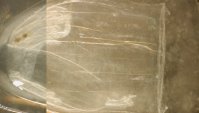
A jelly fish
An arrow chaedognath (brissle mouth) eating the larvae of a krill
Question of the Day:
How would you like to live on a ship? Write me and let me know what your thoughts are.
Answers to Your Questions:
The water temperature yesterday was 41.18 degrees Fahrenheit. The air temperature was 42.8.
Friday, May 25, 2007
The Survey Continues
Sea Wave Height 4 Feet:
Personal Log:
The low pressure system over our heads just will not let up. The seas are a little flatter today and I could sleep last night without feeling like I was going to wind up on the floor. In any ship, the sections at either end, the bow (front) or stern (back) move up and
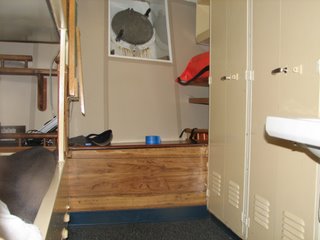 heavy
seas. I’m way up in the bow. My cabin really moves. What does
a cabin look like on a research ship? Well here is mine. Tomorrow we
will take a tour of the entire ship.
heavy
seas. I’m way up in the bow. My cabin really moves. What does
a cabin look like on a research ship? Well here is mine. Tomorrow we
will take a tour of the entire ship.I am also including some unique views of the ship while out at sea. As you can see from the photos, the weather just does not want change.
Science Log:
The work on the survey continues. The ship is moving in a kind of search pattern around the northern section of the Gulf of Alaska. We are looking for Pollock larvae and we are finding many. We are also finding lots of other cool creatures in our nets. Here are a few:
We are still waiting to hear more data from Excalibur, though it has returned some. Keep watching the drifter site for more information. In the mean time, here are some intersting creatures from today's catch. You can double click the photos to make them larger.
This segmented worm usually stays near the bottom. When it is ready to lay eggs, it swims up into the water and scatters its eggs in the water as it goes. We must have caught this one as it moved up off the bottom to lay eggs. Can you see the eggs in the photos?
These are crab zoea. They will become like the crabs we think of later in their lives. The long spines may prevent preditors from eating them.
A smiling face!
This little copepod hasn't been eating crabbie paddies! You can see its dinner both before and after it has been eaten in this photo.
The shell fish here are called thecosomate pteropods. Theco means shell and somate means body. ptero means wing and pod means foot. So they look like shelled winged feet when they move. They eat phytoplankton (tiny plants).
The long white creatures are larvaceans. They move their tails to make a current that moves food into their bodies. Look how many different kinds of creatures there are in these samples we are bringing up!
Answers to your Questions
The ship was pointed at 51 degrees and moving at 355 degrees because the wind was blowing against the side of the ship.
Yes, Morgan, we do experiments 24 hours a day, 7 days a week. Work
continues today as always. Toby, I’ll be back next week.
Marty. Great to hear from you. I will say hello to all. Thanks for the
great information.
Hello to Mrs. Bolte’s Class, Amanda and Ms. Stern’s
Class. Great to hear from you all.
Mrs. Freeley’s Class, we catch only baby fish, but have seen
many other kinds besides Pollock. The scientists, however, are mainly
interested in Pollock. We eat lots of different kinds of fish. Last
night, we had halibut. Tonight, we are having shrimp. And I’m
hungry.
We do take showers, but you have to hang on when the ship moves or you
wind up leaving the shower a little before you planed on it.
How do we sleep? In a “rack,” which is ship-talk
for a bed. It is kind of fun in high seas to lay flat on your rack and
look at your feet going way up above your head as the ship rolls over
the waves. It takes a little getting used to. There is a picture of my
cabin on the blog today for you. There are no animals on the ship this
year.
Thanks to all for writing.
Thursday, May 24, 2007
What Are We Seeing??
Sea Wave Height: 6 Feet
Science Log
Last night around 2:00 AM Alaska Time, we reached the point in the cruise where we were in the right position to deploy our drifter buoy. We stood on the back deck and gently lowered it over the side of the ship and watched it disappear into the Alaska night. Bon Voyage, Excalibur! Click here for the video. We heard from the buoy several times overnight and now are having trouble reaching the website. I will download data as soon as I can.
It was wonderful to see Excalibur in the water. I’m proud of each and every student in Mrs. O’Brien’s Class who worked so hard to put this buoy together. I can’t wait to get back and see the data from the buoy with you.
Another gale has blown in and we are again facing winds above 30 kts. And heavy seas. The work has been tough but we have been able to continue. Well, you have seen how the nets work, you have seen how the lab works. Today I would like to show you some of the incredible creatures that have come up in our tiny nets. The little bowl of reddish liquid you see here holds an incredible array of creatures which make up the plankton community in the Gulf of Alaska. Lets meet a few. We will need a microscope to do it. All of the pictures you see here were taken with a camera mounted to a microscope. But first, will the real Sheldon Plankton from Sponge Bob, please stand up…
This is a baby crab. The female carries the eggs. When they hatch, the float around for a few weeks eating phytoplankton. They go through 3 major stages. This is the last one. At this stage, the crab settles to the bottom and starts to begin life as a bottom dweller. At each stage, these creatures shed a shell, swell with water, form a new shell and then expel the water they absorbed before they grew the new shell. They use the extra space to for real grow before they have to shed again.
This is a pollock larvae. That may be the yolk sack from the egg under its mouth! It absorbs the yolk and then must begin to look for food on its own. You are seeing this pollocks first real meal.
This is what shrimp look like, when they first hatch. Shrimp like this look red to us, but in deeper water, where there is less sunlight, the red looks black, not red. What great camouflage!
Another pollock larvae. You can clearly see the eye and mouth. This pollock does not have a yolk sack, so it has been eating on its own. Do you see the food in its stomach? I wonder what it has been eating. Take a guess and write a comment. There are no real fins at all on this fish, yet. See how small the stomach is? These fish have to find food and find it fast. They cannot store energy in their bodies yet.
Several different types of zooplankton gather around some phytoplankton. Here is the beginning of the food web. The algae in this photo serve as food for many little creatures in the sea. The copepods and other small creatures eat the tiny phytoplankton, and in turn are eaten by small fish.
This is a a creature called a hyperiid amphipod. It is related to a sand flea. They live in plankton. These particular ones will borrow into the surface of jellyfish and ride around on them. They are tiny hitchhikers. They have plates on their abdomen are where the babies stay when they are young.
The storm is really raging now and the seas are getting bigger. I am NOT seasick! That is because of Lt. Sean. He gave me some medicine which seems to be working. Now it is kind of fun to be out her since the waves don’t’ bother me any more. I kind of enjoy the ride now. We are REALLY moving up and down.
Question of the Day
This is a complex one, but an important concept if you ever sail. The ship was facing 51 degrees (North East) when we let off the buoy, but the ship was moving 355 degrees (almost true north). Why would the ship face one way and travel a slightly different way?
HINT: Think about how the storm affects the ship
Answers to your Questions
The answer to yesterday’s question was 12.5 x 24 or 300 kts. or about 345 miles. Congratulations all who got this one correct. Of course, we stop a lot here to take measurements, so we do not go that far in a day.
Many of you asked how much we are finding. I’ll tell you about that in a day or so when the scientists have a better idea of what the data is showing.
We have not seen any sharks. That’s OK with me.
Was it scary to be at sea in a storm? Not really. You get used to the waves after a while. They are really rolling along right now. But people here are used to it and go about their lives as people do.
What was the deepest ocean we have sailed over so far? 240 meters. We will sail over deeper water in the days to come.
Josh, I’m not getting sea-sick anymore, and there are not many people on deck right now because of the storm. Most of us are inside unless we have to work.
Amanda, good question. I don’t really feel the tides, but I know they are there. They just move us around a little, but what I really feel are the waves from the storm.
Hello as well to Lt. Sean’s family. Thanks so much for writing. I’m glad you are enjoying the blog.
Hello to Nazilla and Earnest in Seattle. Thanks for writing.
Excalibur has Been Deployed!!
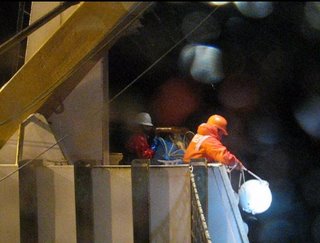
Wednesday, May 23, 2007
What Happens in the Lab
Visibility: 4 Miles
Sea Wave Height: 2 Feet
Personal Log
The weather cleared today. The sea had mercy on us. We are backing under way after taking shelter behind Jacob Island for most of yesterday. The seas are still high but are much calmer and there is almost no wind, so deploying bongo nets has been fairly routine.
I spend much of the morning working on Excalibur. I had to finish reassembling and sealing it up. We plan to deploy the buoy later today at around 4:00 AM New York Time. Right now it is on the back deck strapped down waiting for deployment,
We had a visit today from a land bird. We think it is some kind of plover, which is a bird that lives by the shore. It was probably blown our to sea by one of those 55 mile per hour gusts we had yesterday. It took some time to rest on our ship. I hope it stays for a while. Right now we are headed towards some land and if it stays long enough it will see the land and get back to shore. I’ll let you know what happens.
Science Log:
We spent our day today moving from place to place along our route deploying bongo nets. You saw how that was done in our video yesterday. Now lets take a look at what happens when the bongo nets come back up to the ship. The bottom of the net, called the cod end, contains a sample of plankton from the ocean below us. The scientists are looking for the larvae, or babies, of the fish called Pollock. This fish is the largest commercial catch in the world, and scientists from NOAA monitor the population of this fish very carefully. The bongo has two nets and each one contains a sample. The samples are processed differently.
The contents of the first net are preserved and sent back to the NOAA lab in Seattle, Washington. Some of our samples from this cruise will actually be processed in the country in Europe called Poland. The scientists record the number and type of all the fish larvae (babies) in the entire sample. Some samples will checked for the number and
The second sample is sorted through right here on the ship. All the Pollock babies are photographed under the microscope and measured. For this sample, just the Pollock babies are preserved and sent back to the lab. The rest of the sample goes back into the sea. Back in the lab in Seattle, the scientists can tell how many days old the babies. Other scientists may use those samples for other studies as well.
Want to learn more? Click here for a video.
Tomorrow we will get to look in the microscope and see pictures of what is there.
Question of the Day:
The ship travels at 12.5 kts. per hour. At that speed, how far can it travel in a single day?
Answers To Your Questions:
Thanks all of you for writing. You are right about the function of the suit. It keeps me warm and dry as well as easy to see and safe. We even have one coat that will keep us on the surface of the water if we fall in.
Lets see: I’m letting Excalibur go tonight. The water is COLD, There are about 25 people on board right now, and no animals. It is cold and we have seen one long storm.
Ryan, some plankton are plants. They get their energy from the sun. Zooplankton, which are animals either eat the plants or other plankton.
Dan, I get wet a lot, but we take great care not to fall. The boots I wear keep me standing upright, or at least, they have so far.
Tuesday, May 22, 2007
Storm At Sea
Personal Log
The storm that gathered yesterday hit us full force by the end of the day. The waves were 15 feet and the winds were gale force by evening. What a night! The ship rocked and rolled and the bongo nets flew at us as we tried to bring them on board. At one point, I caught the cod end of the net just before it flew into the side of the ship. It would have broken itself to pieces. When I got up this morning, all was strangely calm and quiet. At first I thought I was getting used to the high seas, then I realized the ship just wasn’t rocking anymore. Was the storm over? No such luck! The storm had gotten so bad it was not possible to deploy bongo nets any more. We had taken shelter in a tiny bay on none other than, are you ready, Jac
What do high seas feel like? Well there a little like being on a roller coaster that goes in lots of different directions, and never comes to an end. At the top of the wave, you get that feeling in your stomach just like you do on a roller coaster. The difference is that you still have to do your work, eat your food and manage to walk around the ship without bumping into anyone, knocking over any equipment, banging into a steel wall or falling down stairs. Yikes.
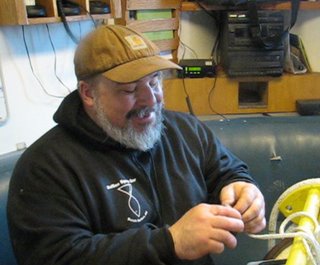
I have a few pictures to send you and some video. Click here for the video of the waves.
So many of you asked for more video of Bruce making rope that we made you another. Here he tells you how to do this yourself. Want to learn more? Click here for the video and Click here for a website on knots!
Today the winch on our Fast Rescue Boat (FRB) was moving slowly. We had to lower the FRB and move it to the back deck near another winch. The FRB is important for safety reasons, so this had to be done. Take a look at the crew moving the boat around in a storm!
Science Log:
Well, there isn’t a whole lot going on in our little study today. And that is going to cause us to loose some parts of our study. Chief Scientist, Annette Dougherty has been studying our route trying to figure out which stations along the way that we will NOT be able to get to. After all, the ship still has to dock in Kodiak on the 28th of March. So every moment we spend in this little bay is time away from the study these scientists are doing. But that, in the end, is how field work functions. There are no guarantees when you are in remote areas like this, and studies are frequently affected by weather and other elements and have to figure out ways to deal with it.
Excalibur Update: We are about 24 hours away from the furthest point of land. That’s where the scientists say to deploy the buoy. Of course, we have to wait for the weather to clear before we move out, so I will just have to keep you posted.
I understand some of you had trouble seeing the bongo nets video yesterday. Here is another link, please try again.
Question of the Day:
Given what you have seen so far, tell me if you would like to spend time at sea or not? Why or why not?
Answers to your Questions and Comments:
I’m glad many of you answered that you would wear safety gear. Many people don’t realize how important it is. We do not always have the gear on. We just use it when we are doing operations on deck where there is some risk involved. When we are below decks, we wear street clothes, but we have lots of safety equipment nearby if we ever need it. It is a little heavy and cumbersome at first, but you get used to it. The gear does not make you feel like you are going to fall in. In fact, part of our gear involves a rope we use to tie into the ship. This keeps us from falling off when we are near the edge. But if we wind up in the water, our gear always includes flotation to keep us at the surface.
Thanks to all of you for writing. Here are answers to some of your questions. Do we have to wear safety gear when we are sleeping? No, we have a survival suit and other gear near us in our quarters, but we only have to put on gear if there is an emergency or if we are doing operations outside on deck.
Is the ship clean? Yes, Sangeetha, the crew do a good job of keeping things as clean as possible. But when you work on a ship, there is dirt around.
I will be bringing back samples of plankton to school.
Sophia, I saw the skull on the side of the road because Bruce, the chief boatswain on this cruise pointed it out to me and stopped so I could photograph it. Thanks, Bruce.
Many people asked when I will be back. I am scheduled to fly on the 29th and will arrive very early in the morning on the 30th.
A lot of you are asking questions about the plankton. My plan is to show you the lab tomorrow (I was going to do it today, be we are not working right now due to the weather). The next day I will show you about the plankton we are finding. So, keep checking back! I’ll be sure to tell you how much we are finding and how that compares to last year. Good questions!
Many of you asked about the radar. It is used to look for ships and rocks that might be anywhere around the ship.
Sam, we are 4 hours behind you. So when it is 9:00 AM in New York it is 5:00 AM in Alaska.
By the way, no one, not even me, has fallen in the water this cruise.
Have I gotten sea sick yet? Yes! In fact, I’m not the only one here. The waves have been huge!
I do miss Rusty. I had not heard cats bring luck. I’ll ask around about that.
I’m glad many of you liked the whale picture. I saw it off the bridge wing. It was swimming by. We did not hurt it or do anything to it at all other than take it’s picture and say hello as it passed by.
Another special hello to Simon and Nicky. Thanks for writing. Another special hello to Mom and Pop (Lillian & Bob) in Sacramento. Thanks for checking the blog.
Photos:
Bruce Knoepke, Chief Boatswain on NOAA Ship MILLER FREEMAN making knots
Flat Stanley at the microscope
Jacob Island
The crew, including Chief Survey Technician Philip White moving the FRB to the back deck of NOAA Ship MILLER FREEMAN
Monday, May 21, 2007
Bongo Nets
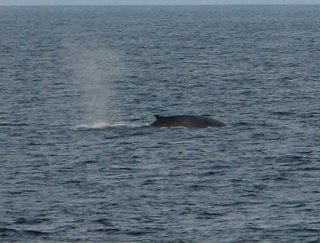 NOAA Teacher At Sea: Jacob Tanenbaum
NOAA Teacher At Sea: Jacob TanenbaumPersonal Log:
So far the weather has been great and the sailing has been smooth up to today... Perfect for whale watching off the bridge. Here is a picture of a minke whale we sighted late last night. These nice few days are letting me get re-adjusted to being out at sea. The Gulf of Alaska is not always this easy. In fact, a low pressure system is moving in right now and the ship is finally starting to shake. At least I have had a few days to get used to being out at sea. Do you think I will get sea-sick?
Flat Stanley has been sighted all over the ship these last few days. Here he is on the bridge checking the radar.
I have some other news for you: Rusty the ship’s cat is now living in Seattle, Washington with Nancy, a former crew member who retired at the end of last year. She was Rusty’s main caretaker and Rusty went along with her as she left the ship. Rusty is missed by all, but is happy climbing trees in Seattle, which is a beautiful city in Washington State, in the Pacific North West. Bon Voyage, Rusty!
Science Log:
We continue taking samples of plankton all along the Gulf of Alaska just south of the Alaska Peninsula. We are using a special net called a bongo. There are two nets with a very fine mesh, just about the size of the screen on your window in the summer. It is put in the water behind the ship and lowered towards the bottom and then raised again. Fish can usually avoid the small opening at the top of each net, but plankton cannot. They come up in the net and are washed down into a sample bottle at the “cod end.” It is a complex process to deploy the net. It is heavy and must be moved with a winch while two of us maneuver it on and off the ship. Take a look at this video. Which shows the process in detail.
Tomorrow, we will look at how the lab works.
We will also make an attempt to drop the buoy in the next day or so. An attempt means we want to make sure the water and wind are moving in the right direction for us. I’ll keep you posted.
Question of the Day:
On some ships, like the ones featured on many TV shows, the crew often do not wear harnesses, flotation or hard hats. Other ships, like NOAA Ships, will not let you on deck during operations without that kind of gear. The gear is heavy, cumbersome, and takes time to put on, but it does help keep you safe. Which would you prefer for yourself and why?
Answers to Your Questions and Comments:
Many of you answered correctly that the suite is orange so the wearer can be seen easily in case the person falls into the water. Orange is a great color for safety. It shows up against just about anything in nature; green plants, blue water, ice and snow, sandy deserts.
Many of you asked about the weather. It has been in the 50’s sometimes in the afternoon, but most of the time it has been in the 40’s with wind. Now the wind and waves are picking up a little and the temperature is starting to drop down. We may get rain or even sleet in the next few days. I have not been sea-sick yet, but… we’ll see.
Ms. Begin’s class, great questions. The ship travels about 14 miles per hour. Have I been frightened? No, when I see all the safety precautions NOAA takes, I know they take my safety and that of everyone on the ship very seriously. That makes me feel secure. So, yes, all the gear I wear is heavy, but falling into the Gulf of Alaska the storm that is coming up would feel a whole lot worse! I don’t mind wearing the gear at all.
And, yes, I do miss my family. A special hello to my two boys Simon and Nicky. Hello to Annie and Sean as well.
Sunday, May 20, 2007
First Day of our Study
Personal Log:
This morning we were treated to a spectacular Alaska dawn. This time of year up here, the sun takes a long time to come up, so dawn begins early and the light stays beautiful for ages. Here are some photos. There are more in the gallery section of the website as well.
Today we also had more drills to practice what to do in case of an emergency. On a ship, in addition to having fire drills, we also have “abandon ship” drills. Here, members of the crew, including “Flat Stanley,” our visitor from Virginia, all “muster” with their flotation and survival gear next to our life raft station.
Science Log:
The scientists worked all night collecting plankton samples. One of the main interests is collecting the larvae, or baby Pollock. Remember the fish we studied here last summer? Well this year, we are studying baby Pollock. Baby Pollock, or Pollock larvae are considered part of the plankton community because they are not strong enough to swim against the current. The samples we take here are very different from the ones that we took last summer. Here are some samples side by side. Last year we had to lift our samples on to the ship with a crane. Today, our samples come in small bottles and petri dishes. What a difference!
This is what Pollock look like as adults:
This is what they look like as larvae (babies)
Here is a sample of adult pollock from last year
Here is a sample from this year
Here is how we measure adults
Here is a photo of us bringing up the nets, called bongos, full of plankton.
Question of the day:
Why do you think it is important to study babies? Students on Monday, please look at yesterday's log and answer those questions too!
Photos
Sunrise in Alaska
Crewmembers of NOAA Ship MILLER FREEMAN muster for an abandon ship drill
Adult Pollock and NOAA Teacher At Sea Jacob Tanenbaum in June of 2006 on NOAA Ship MILLER FREEMAN
Pollock larvae under the microscope
Haul of Adult Pollock from June of 2006
Pollock larvae in a petri dish
Measuring adult Pollock in June of 2006
NOAA Teacher At Sea Jacob Tanenbaum at the microscope on NOAA Ship MILLER FREEMAN
Chief Survey Technician Philip White and NOAA Teacher At Sea Jacob Tanenbaum bringing in bongo nets on NOAA Ship MILLER FREEMAN
Saturday, May 19, 2007
Leaving Dutch Harbor
Wind Speed: 11 nautical miles per hour
Pressure: 1018 Millibars
We left Dutch Harbor and are now at sea. My blog entries from now on will take the form of the Teacher At Sea program logs.
There was a lot of interesting wildlife all around us. A trawler had brought up the skull of a whale from the bottom of the sea. They had it on display around a nearby pier. As we were getting ready to leave port, a sea-lion came by to see us off. You will never guess who was on the bridge when we left Dutch Harbor: A Flat Stanley had come to visit from an elementary school
Finally, the moment came. We left Dutch Harbor. Click here for a video of the ship pulling out of port. It is not an easy process to maneuver a ship this large, but watch how these experts make it all seem easy.
Science Log
Today we prepared all of our supplies for the FOCI survey. This included inspecting the nets, unpacking materials for collecting specimens and wiring up microscopes. We will begin our fir
Finally, all the scientists must have training in the safety protocol for the ship. We all tested and tried out our survival suites today. These suites will keep us dry and safe in case something happens while we are out at sea. It is kind of like a fire drill for sailors. Here I am suited up in our bright orange survival suit. Do you like the color?
Question Of The Day: Why do you think the suit is bright orange?
Friday, May 18, 2007
Hello from Dutch Harbor and NOAA Ship MILLER FREEMAN
As you can see from the test data, the buoy has not yet been deployed in the water. I will let you know when and where we plan to put it in the water.
Alaska is cold, mainly because the wind has been blowing very hard. The mountains are still full of snow. It is everywhere you look. Still, I love being out-doors no matter what the temperature. I have spent the last few day
It is interesting to hike on the tundra here. It is very soft and full of life, this time of year. There are almost no trees on this entire island, but I did find one lonely pine on a mountain overlooking Captain’s Bay. There are no others that I can see for miles!
Many people asked for photos of the crab fleet featured in the show Deadliest Catch. Here are a few photos of crab boats. Most of the fleet is docked here right now waiting for the season to open in October.
A few of you asked for photos of the school here is Dutch Harbor. Here is a photo of that as well. They have two schools. One is Kindergarten –4th grade, the other 5th through 12th grade. You can read about the district here: http://www.ucsd.net/ How is it similar to where you
Thursday, May 17, 2007
Greetings from Alaska
The mechanic finally arrived and we got back on-route. We arrived in Anchorage 4 hours late. It was midnight Alaska time, or 4 in the morning New York time. You guessed it, I was tired.
Here are some photos of Anchorage. It is the largest city in Alaska. It has many thin
4th and 5th graders, here is another question for you: This morning I am getting ready to go to the town of Dutch Harbor on the Aleutian Islands. Can you measure the route to Dutch Harbor from Anchorage using Google Earth? The plane will take 3 hours (I hope) to get there. How fast will it go?
Friday, May 11, 2007
I'm Off to Alaska
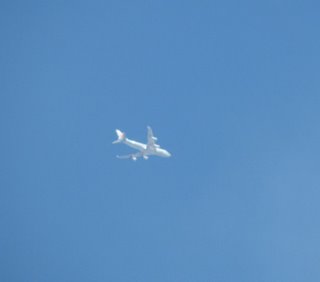
Day 1
Day 2
I hope to have Internet along the way to upload some pictures. If not, I'll meet the ship on Friday and should have Internet over the weekend to write more. Talk to you soon...
Mr. T.
Thursday, May 10, 2007
What Pictures and Video Would You Like to See?









